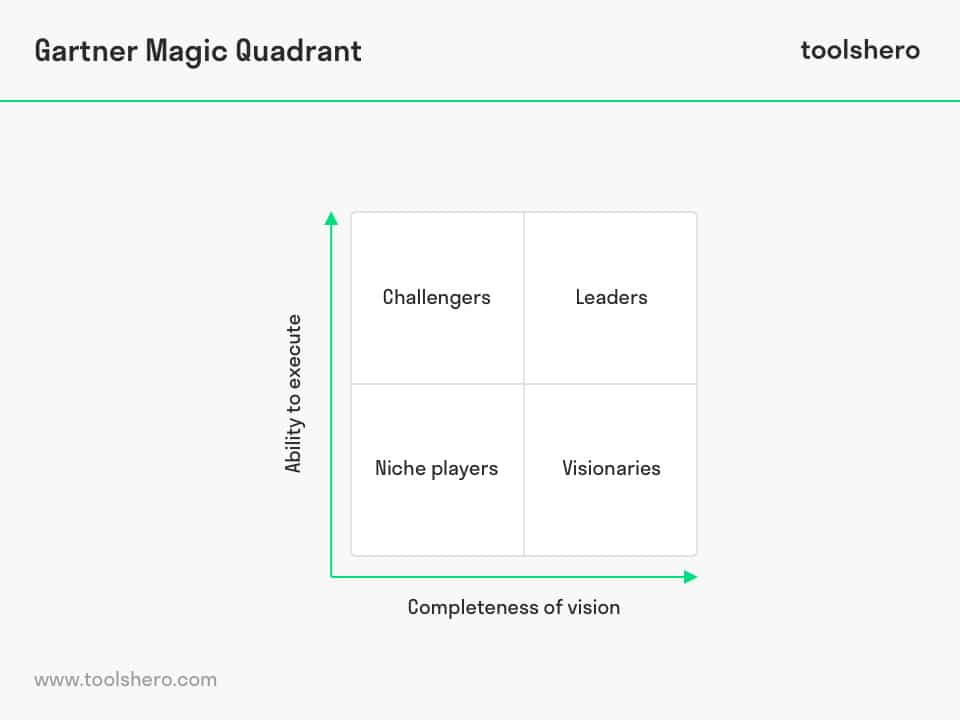Gartner Magic Quadrant report and basics explained

Gartner Magic Quadrant: this article will explain the research method of the Gartner Magic Quadrant. Next to what it is, highlights this article also how it works in practice, the assessment criteria adn a short summary. Enjoy reading!
What is the Gartner Magic Quadrant?
Gartner Magic Quadrant is a research method and visualisation tool for monitoring and evaluating the progress and position of companies in a specific, technology-based market.
A new magic quadrant is published every year. The analysis is done based on two criteria: vision and the ability to execute. Based on this, companies are classified as either a niche player, visionary, challenger, or leader.
The research reports can be very useful tools for investors looking for a company that meets their needs, and for companies who want to compare their market competitors and gain the upper hand.

Figure 1 – Gartner Magic Quadrant
What can you use the Gartner Magic Quadrant for?
The research method can be used as a first step to gain insight in the technology suppliers that you’re considering for investment. In addition, the magic quadrants can also be a useful instrument for suppliers looking to analyse their competition. This is because it gives an overview of the top companies of a market, including their strengths and weaknesses.
Competing businesses can then use this information to improve their own company in areas where others are weak, giving them a market advantage.
How does a Gartner Magic Quadrant work?
The magic quadrants use a two-dimensional matrix in order to demonstrate companies’ strengths and differences. The display divides competing businesses into four different quadrants based on both their completeness of vision and their ability to execute.
Leaders
Leaders perform well in terms of their current vision and are well positioned for the future. Score high on both completeness of vision and the ability to execute.
Visionaries
Visionaries understand where the market is going or have a vision for changing market rules, but aren’t executing them properly. Are aware of how the market evolves and can be potentially innovative, but might not be able to execute these visions.
Niche players
Niche players successfully focus on a small segment or are unfocused and don’t innovate or perform better than others. Have low scores both when it comes to completeness of vision and the ability to execute.
Challengers
Challengers are performing well today or can dominate a large segment, but don’t show insight into the market. Have the ability to execute, but might lack a strong vision.
Advise
Gartner advises users to research all quadrants, as companies in each category have their own unique strengths and weaknesses that have to be taken into account.
Gartner’s point is that the companies categorised as leaders aren’t always the best option.
Assessment criteria per axis
Completeness of vision (horizontal)
- Market knowledge
- Offering a (product) strategy
- Innovation
- Marketing strategy
- Vertical/industry strategy
- Sales strategy
- Geographical strategy
Ability to execute (vertical)
- Customer experience
- Opportunities
- Professionalism
- Viability
- Sales (price)
- Performance
Gartner Magic Quadrant summary
The Quadrant recognises organisations that have achieved a high level of consistency and quality when it comes to supplying small and scaleable infrastructure services, and that have a positive track record when it comes to outsourcing data centre capacity.
In addition, it represents the evolving way in which organisations use and manage IT in an age that requires a holistic approach and the ability to adapt.
Now it’s your turn
What do you think? Are you familiar with this explanation of Gartner’s ‘Magic Quadrant’ or want to add something? In which scenarios do you think this analysis will be effective?
Share your experience and knowledge in the comments box below.
More information
- Hagerty, J., Sallam, R. L., & Richardson, J. (2012). Magic quadrant for business intelligence platforms. Gartner for Business Leaders (February 6, 2012).
- Hill, J. B., Cantara, M., Kerremans, M., & Plummer, D. C. (2009). Magic quadrant for business process management suites. Gartner Research, 164485.
- Snapp, S. (2013). Gartner and the Magic Quadrant: A Guide for Buyers, Vendors and Investors. SCM Focus.
How to cite this article:
Sari, J. (2018). Gartner Magic Quadrant. Retrieved [insert date] from Toolshero: https://www.toolshero.com/marketing/gartner-magic-quadrant/
Original publication date: 11/15/2018 | Last update: 03/25/2024
Add a link to this page on your website:
<a href=”https://www.toolshero.com/marketing/gartner-magic-quadrant/”>Toolshero: Gartner Magic Quadrant</a>












